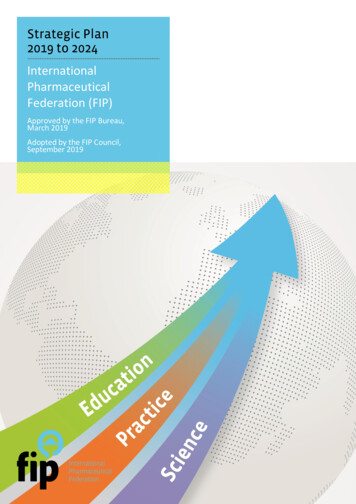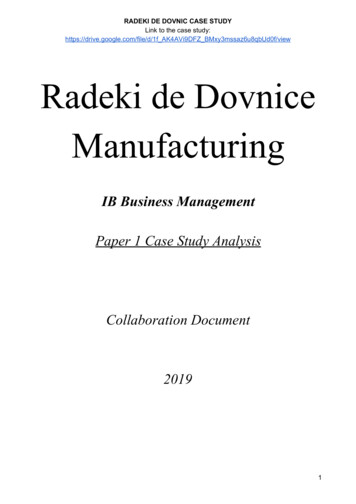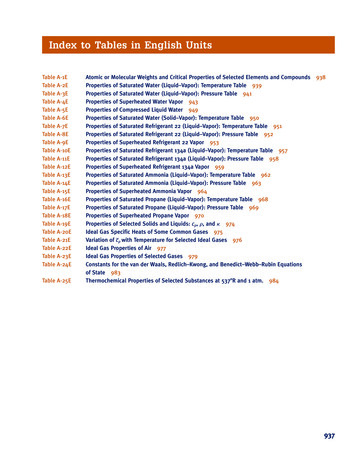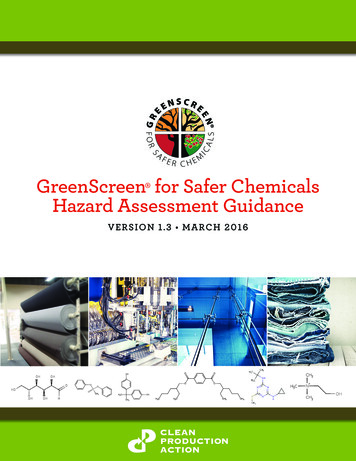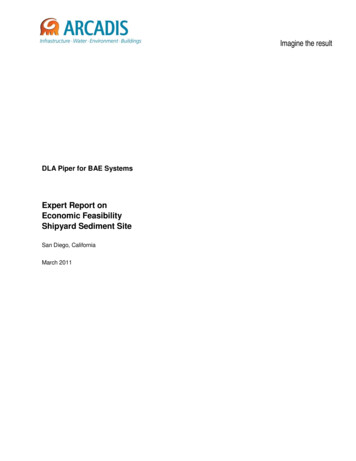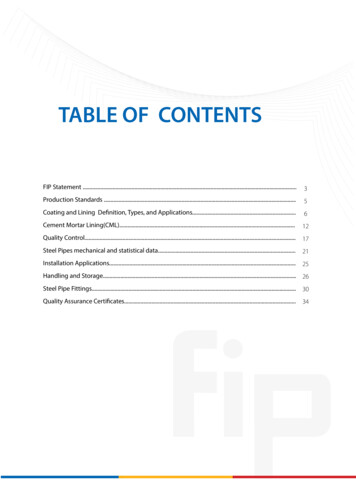
Transcription
TABLE OF CONTENTSFIP Statement .3Production Standards .5Coating and Lining Definition, Types, and Applications.6Cement Mortar Lining(CML).12Quality Control.17Steel Pipes mechanical and statistical data.21Installation Applications.25Handling and Storage. 26Steel Pipe Fittings. 30Quality Assurance Certificates.34
Dear Valued Customer,Thank you very much for your interest in our company. Future Iron Pipes provides water networksinfrastructure solutions that exceeds your requirements. our products portfolio includes externallycoated black and galvanized steel pipes. External coating is 3LPE, 3LPP, FBE and FBP. in addition, blacksteel pipes are internally lined by cement mortar. In this catalogue you can find all information aboutour products and their applications. We are at your service. for further information please contact us at :Dura, Hebron, West Bank, PalestineTel. 970 2 2265321Fax. 970 2 2265322Email: info@fip.pswww.fip.ps2
Future Iron Pipes (FIP) is recognized as a key manufacturer of coated and lined steel pipes in Middle Eastand the Arab World. The company provides a wide range of external coating applications including 3LPE,3LPP, FBE and FBP in compliance with national and international standards PS, AWWA, DIN, BS,ASTMand any other specific requirements.The production of FIP has been recognized by its quality, accuracy, and reliability. Our brand, products,and services have been approved, selected, appreciated and accredited over time, assuring the highestquality measures to every client.Originality, projection towards the future, dynamic relationships with market segments and constantdevelopment; that’s what FIP stands for. We are fully prepared to meet the needs , demands generatedby the expansion of water distribution systems, natural gas, oil pipelines and related projects.Future Iron Pipes provides external anti-corrosive, 3 layered PE/PP coating according the internationaland Palestinian quality measures, plus internal cement mortar lining for pipes. Our capacities are alwayssatisfying , and many times exceeding local demands. Established over 16000m2 space, FIP utilizesa computerized and modern coating system, and a production capacity that exceeds an average of1,500,000 linear meters of coated pipes per year. We serve our clients in pipe diameter range from1/2” -16” (15 mm – 400 mm) and length ranges from 6.0 meters to 12.2 meters.: شركة المستقبل لألنابيب المعدنية وهي الشركة الوحيدة في فلسطني التي تقوم بعزل األنابيب التي تتراوح أقطارها من .2008 تأسست شركة املستقبل لألنابيب سنة 16“ إلى 3“ من اخلارج بثالث طبقات ومن الداخل بطبقه من املالط اإلسمنتي لألنابيب التي تتراوح أقطارها من 16“ إلى 1/ 2”. باإلضافة لطالء األنابيب مبادة االبوكسي من اخلارج منتجاتنا تستخدم في مشاريع البنية التحية والتي تتضمن شبكات وخطوط املياه والغاز واﺠﻤﻟاري (الصرف الصحي) واحلريق وجميع األعمال . ذات الصلة الشركة حاصلة على العديد من الشهادات احمللية والعاملية التي تضمن لزبائننا منتجات ذات جودة عالية ومنها شهادة اجلودة .DIN واألملانية AWWA ومطابقة للمواصفة األمريكية ، )ISO9001:2008( شهادة إدارة اجلودة العاملية , )PS325( الفلسطينية : منتجات الشركة .)3LPE/3LPP( أو البولي بروبلني ومن الداخل باملالط اإلسمنتي / أنابيب معزولة بثالث طبقات من البولي ايثيلني .)FBE( أنابيب مطلية ببودرة االبوكسي حتت التأثير احلراري لألنابيب املغمورة باملياه أو السطحية .)FBP( أنابيب مطلية ببودرة البوليستر حتت التأثير احلراري وذلك ألنظمة إطفاء احلريق .)Steel Pipes Fittings( عزل وصالت األنابيب بأنواعها اﺨﻤﻟتلفة من الداخل باملالط اإلسمنتي 3
4
Production standards :Related standards and specificationsOriginStandardDescriptionExternal coatingPalestinianPS 325-6AmericanAWWA C215GermanDIN 30670BritishBS EN ISO 218091:2011GermanDIN 30678Steel pipes with protective coatings –external extruded polyethylene coating –three layercoatingExtruded polyethylene coatings for exterior of steel water pipelinesPolyethylene coatings of steel pipes and fittingsPetroleum and natural gas industries. External coatings for buried or submerged pipelinesused in pipeline transportation systems. Polyolefin coatings (3-layer PE and 3-layer PP)Polypropylene coatings for steel pipesInternal cement liningPalestinianPS 325-1AmericanAWWA C205Steel pipes with protective coating-internal coating by cement mortarCement–Mortar Protective Lining and Coating for Steel Water PipeExternal paintingAmericanAWWA C210Liquid-Epoxy Coating Systems for the Interior and Exterior of Steel Water PipelinesAmericanAWWA C213Fusion-Bonded Epoxy Coating for the Interior and Exterior of Steel Water PipelinesSteel pipesPalestinianPS186Steel welded pipes for general usePalestinianPS141Steel pipes suitable for screw threadingGermanDIN2440Steel tubes medium weight suitable for screwingGermanDIN 2441Steel tubes; heavy-weight threaded pipesAmericanASTM A53Pipe, Steel, Black and Hot-Dipped, Zinc-Coated, Welded and SeamlessAmericanASTM A106Seamless Carbon Steel Pipe for High-Temperature ServiceAmericanASTM A795Black and Hot-Dipped Zinc-Coated (Galvanized) Welded and Seamless Steel Pipe for FireProtection UseAmericanASTM A589Seamless and Welded Carbon Steel Water-Well PipeAmericanAPI 5LAmericanAWWA C200Steel Water Pipe—6 In. (150 mm) and LargerAmericanASME / ANSIB36.10welded and seamless wrought steel pipeWelded and Seamless pipe suitable for use in conveying gas, water, and oil in both the oiland natural gas industriesSI 530steel welded pipes for general useSI 103Steel pipes suitable for screw threadingJordanianJS1832:2008 ASTMA106:2006JordanianJS 137-2006Standard specification for seamless carbon steel pipe for high -temperature servicePipe-steel pipes welded and seamless used for gas and waterQuality management standardInternationalISO 9001:2008Quality management systems*Please contact us for your special requirement out of our general production standards .5
Coating and lining:Definition, Types, and ApplicationsFuture Iron pipes provides many steel pipes coating options including Polyethylene, Polypropylene,Epoxy, Polyester and Internal cement liningTypes of coating and lining : 3LPE :Three Layer Polyethylene Coating.3LPP : Three Layer Polypropylene Coating.FBE: Fusion Bonded Epoxy Powder Coating.FBP: Fusion Bonded Polyester Powder Coating.Cement Mortar Lined Steel Pipe.Fusion bonded epoxy / Polyester powder coatingDescription:FBE: Fusion Bonded Epoxy Powder coatingFBE is a high performance anti-corrosion coating that provides excellent protection for small and largediameter pipelines with moderate operating temperatures. The thickness of the FBE coating is up to 400microns.FBP: Fusion Bonded Polyester Powder coatingFBP is widely used in fire fighting piping systems applications. pipes are coated with polyester powderwith a minimum thickness of 150 micronsProduction stages :Abrasive cleaning with steel grit/shot is required to achieve a surface purity grade of Sa 2 1/2 with aroughness of (40-90 μm). The steel must reach a temperature of 170-220Co.The FBE/P is deposited by anelectro-static spray process. The coating cures quickly. Once cured, the pipe is cooled for safe handlingand inspection.6
Three Layer Polyethylene / Polypropylene coatingDescription:The 3-layered Polyethylene (3LPE) is a multilayer thermoplastic coating designed to provide maximumlong term corrosion resistance and mechanical protection to steel pipes. This technology has theadvantages of excellent adhesion, long term corrosion resistance, cathodic dispondment and impactresistances properties that are essential for maintaining pipelines integrity and durability.The layers are composed of: Base layer (Epoxy): The Epoxy layer protects steel pipes, improves the pipes surface adhesion andresistance to cathodic dispondment.Adhesive layer: This layer improves the adhesion of the polyethylene layer to the epoxy layer and tostrengthen its resistance to peeling.Polyethylene layer: Protects the previous layers from any mechanical damage or corrosion, it alsoworks as an electric insulator to steel pipes.7
Production stages :1First stage :2Second stage :3Third stage :4Fourth stage :8The surfaces that are to be coated shall be firstthoroughly cleaned from any dirt ,rust and scales. thepipes surfaces are cleaned by blasting them with steelshot grit to a cleanliness degree of Sa 2 1/2Cleaned pipes are then heated to 180-200 CSpecial powder epoxy paint (FBE).This layer providescorrosion resistance to steel pipes by an electro-staticspray process to a thickness larger than 60 microns.Special adhesive is applied to pipe surfaces by extrusionmethod. the adhesive layer bonds the FBE layer withthe PE layer.
5Fifth stage :Polyethylene/ Polypropylene is applied by extrusionmethod according to the specifications and technicalrequirement. Polyethylene layer ensures protectionagainst mechanical damage and excellent protectionagainst risks such as heat and UV layer.The following table shows 3LPE external coating overall thickness :Thickness(mm)Pipe size (inches )NormalMediumUp to 4"1.51.8Larger than 4"-10"1.82.0Larger than 10"-16"2.02.2Large2.52.72.9Data is in accordance with PS325 and DIN306706Sixth stage :7Seven stage :pipes are cooled immediately after extrusion for safehandling and inspectioncoating ends are removed to facilitate the weldingprocess of pipes ends9
Marking:Each pipe is marked with the following data Pipe manufacturer’s code or name.Nominal Pipe Size (NPS)Wall thickness measured in mm.Grade of pipe.The word (3LPE).Coating thickness.Applicable standards.The date and hour of production (dd/ mm/yy, hh:mm).Advantages of 3LPE systems: 10High resistance to penetration.High compressive and impact strength.High rigidity.High elasticity and resistance to tearing.High electric insulation.High resistance to chemicals and oxidizationWithstanding high temperatures ;( PE resists up to 70Co, while PP resists up to 120Co.)
Did you know?,,3LPE coated pipes ensures an extendedlifetime for steel pipes up to 50 years!!11,,
Cement Mortar Lining(CML)Introduction :The internal cement mortar lining provides protection to pipelines interior surface. in two ways. First, itis a “cement pipe within a steel pipe”. Second, by creating a “Zone of Alkalinity”. This zone between thecement lining and the pipe wall, neutralizes the corrosive properties of the liquid medium and blockscorrosion of the pipe wall. As a result effect, the “Zone of Alkalinity” serves as a second layer of defenseagainst internal corrosion. Unlike other types of internal linings, which allow pipe corrosion to spreaddown the line once they are chipped or damaged in any spot, the cement lining prevents corrosionfrom spreading along the pipe wall.Description:Cement Mortar Lining (CML) is a centrifugally applied continuous lining of dense Portland cementmortar with a smooth and uniform finish. This product was developed to provide an economical formof internal corrosion and abrasion protection for potable water pipes.Sulfate Resistance Cement (SRC) is primarily used when the nature of the environment is highlyconcentrated with sulfate that would generate several reactions that could attack the cement anddamage it , such as sewage water and highly concentrated soils.Advantages: Excellent durability to sulfate attack due to low C3A and low alkali content High strength.12
Production stageslining is applied by using a high-speed centrifugal process. this method assures, excellent quality controlof cement-mortar lining. FIP produces cement lining products that are dense, smooth, uniform, wellbonded to the pipe wall, and offer very little frictional resistance to water flow.the production processes are summarized as shownStageDescriptionIllustrationCleaningThe internal surface of the pipe is cleanedfrom any mill residues or tabulations or anyaccumulation of dirt, rust or oil and grease.LancingThe machine is calibrated to apply a specificamount of cement according to the pipe size andthe required thickness of the coating and then thecement is applied to the pipe using a cement hose.SpinningThe pipe then is spun to distribute the cementuniformly using centrifugal spinning in this waythe water to cement ratio is lower and the liningwill have improved cement strength.CuringAfter spinning the water is expelled from the pipethen the pipe is closed with a cap to ensure goodhydration of the cement mortar, the humidityand temperature are controlled to maximize thestrength of the mortarLining ThicknessPipe Size (inch)Lining Thickness (mm)Allowed Tolerance (mm)3-6"4-1.0 , 2.08-10"6-1.5 , 2.012-22"8-1.5 , 3.0Lining Thickness(mm)Allowed Tolerance (mm)According to PS325-1Pipe Size (inch)4-10"6-1.6, 3.211-23"8-1.6, 3.2According to AWWA C205-0713
Materials and Application Raw materials. SandFine aggregate for cement mortar consists of sea washed sand, with a 100% percent passed Sieve No. 4.Sand provided to the plant is usually sieved in order to prevent any larger size stones from entering themixture. When the source of material is changed, new sieve test is conducted. CementPortland cement / Sulfate resistance cement.The used cement is stored in a weather-tight, dry, and well ventilated conditions. WaterThe water used for cement mortar and for curing linings shall conform to the applicable requirementsof ASTM C94. The used water is fresh potable drinking water, free from injurious amounts of oil, acid,strong alkalies, salts and organic matter.14
Mixing and applicationPreparations:Before lining, surfaces to be lined shall be cleaned to assure the removal of any impurities and millresidues that could affect the adherence between the lining and the pipe internal surface. The mixtureshall be homogenous and free of any impurities that affect the lining quality.Placement:During the application of the lining by a spinning machine, the entire quantity of mortar required forthe completion of the lining of the pipe section shall be placed without interruption. After the cementmortar is distributed to a uniform thickness, the spinning speed is increased to produce a dense mortarwith a smooth surface. Surplus water is removed by tilting the pipe when moving on the outbound rack.The lining at the ends of the pipe section shall be left square and uniform with respect to the longitudinalaxis of the pipe, and the lining holdbacks shall be as specified by the purchaser for the type of jointrequired. The default ends have no holdbacks.Curing:Immediately after the completion of spinning, the pipe sections are moved to a curing area. Care shallbe exercised to prevent damage to the lining. The total curing period shall be equivalent to 96 hr ofmoist cure and the minimum, pipe ends are covered with plastic during the curing period.Sampling and testing:Compression test samples of (10cm x 10cmx10cm ) are prepared to achieve the quality controlrequirements of the used standards or the client requirements.15
16
Quality controlThe quality control starts with metallographic inspection of raw material and continues up to shippingstage. Quality control processes , final inspection and laboratory tests are done in accordance with thefollowing national and international standards.1.2.3.4.PS 325AWWA C215-04DIN 30670AWWA C205-0717
Tests and inspections1Cleanliness and roughness test.2Thickness of overall coating .3Coating continuity.4Wet & Dry cement thickness .5Wet & Dry cement surface .18
Laboratory tests:1Peeling test.2Impact test.3Penetration assessment.4Elongation test. Cement mortar - lining laboratory testsCompressive strength.Water /Cement ratio after centrifugal applying of cement –mortar.Cement /Sand ratio.19
Our quality control plan is summarized as follows :20Type of testMethodFrequencyPipe surfacevisualevery pipeBlast cleaning and roughnessusing special measuring devicetwice per shiftPipe temperatureheat sensorcontinuouslyAppearance and continuityvisualevery pipeCoating thickness testingthickness gaugethree times per shiftCut backmeter tapeonce per shiftHoliday inspectionon-line holiday detector100%Impact resistanceaccording to standardsonce per orderAdhesion (Peeling resistance) testaccording to standardsonce per orderIndentation testaccording to standardsonce per orderElongation testaccording to standardsraw material change/ customer request
Mechanical, and statistical data of steel pipes:Pipes nominaldiameterDN 42026.7Nominal weight (Kg/m)Wall 1.581.591.651.6612533.40.1283.252.442.462.532.551 1/43242.20.1283.253.143.173.263.291 4.8519.2019.8019.7020.30BPE: Black Plain EndBTC: Black Threaded CoupledGPE: Galvanized Plain EndGTC: Galvanized Threaded CoupledHydro test at a pressure of 50 bar.1:Grade B11(DIN 2440 / SI 103 / ASTM A53 / PS 141 )21
Mechanical, and statistical data of steel pipes :PipesnominaldiameterDN 2.6048.01 1/43242.20.1403.563.393.403.513.5276.01 511.5511.61172.0Nominal weight (Kg/m)Wall thicknessTest BPE: Black Plain EndBTC: Black Threaded CoupledGPE: Galvanized plain endGTC: Galvanized Threaded Coupled1:Grade B(ASTM A 53 SCH 40) ERW / SeamlessBlack Steel PipesOutside DiaInch3468mm88.9114.3168.3219.1Test Pressure(Bar)Allowable WorkingPressure(Bar)Wall ThicknessC-MthicknessWeightpipepipe 72071051221477/1611.1165765.326.818.5268(ASTM A53 / ASTM A106 / API 5L / ( ASME / ANSI B36.10 ) / SI 530 / PS186)22Flow DatapipeC-MI.D
WeightOutside DiaInch10121416mm273.1323.9355.6406.4Test Pressure(Bar)Allowable WorkingPressure (Bar)Wall ThicknessC-MthicknesspipeFlow Datapipe 6.536.81065(ASTM A53 / ASTM A106 / API 5L / (ASME / ANSI B36.10) / SI 530 / PS186)23
Mechanical, and statistical data of steel pipes(Cont):fire fighting pipesDimensions, Weights, and Test pressure for light weight fire protection pipe—Schedule 10(A)Dimensions & WeightsNPS DesingnatorOutside DiameterTest pressurePlain end pipesweightNominal wall thicknessFurnace -weldedSeamless and ERWinmminmmlb/ftKg/mPsiMPaPsiMPa3 40.1092.771.412.095003.457004.8311 41.66042.20.1092.771.812.695003.4510006.8911 .30.1092.772.643.935003.4510006.8921 .90.1203.054.346.465003.4510006.8931 le 10 corresponds to Schedule 10S as listed in ANSI B 36.19 for NPS 3 4 through 6 only.BFurnace-welded pipe is not made in sizes larger than NPS 4.CNot Schedule 10.Dimensions, weights, test pressures for standard-weight fire protection pipe—Schedule 30and Schedule 40Dimensions & WeightsNPS DesingnatorNominal wall thicknessThreaded withcouplings BPlain endFurnace -weldedSeamless andERWinmminmmlb/ftKg/mlb/ftKg/mpsiMpapsiMpa1 20.84021.30.1092.770.851.270.851.277004.837004.833 1.31533.40.1333.381.682.51.682.57004.837004.8311 11 921 6.8931 0273.10.307AANPS 1 2 through 6—Schedule 40; NPS 8 and 10—Schedule 30.BBased on 20-ft (6.1-m) lengthsCFurnace-welded pipes are not made in sizes larger than NPS 4.(ASTM A795 )24Outside diameterTest Pressure
Heat shrinkable sheetsHeat Shrinkable Sheets:Heat shrinkable sheets are used to cover the welding area between two pipes in order to make sure thatno corrosion is permitted in the area of welding to ensure full protection of coated pipes.Future Iron Pipes recommends the use of these sheets.Basic installation of Shrinkable Sheets: Clean the area with steel wire brush, including 10 cm of the PE coated pipes ends. Heat the pipe with a gas burner to 70-75Co. Apply shrinkable sheets and make sure to press all over the pipe while heating. Finally heat theadhesive layer at the end of the sheet.Advantages of shrinkable sheets: Field friendly. No high pre-heat required. Easy to install. Low cost.25
Handling and Storage:A reasonable amount of care in handling the pipes should be taken during stockpiling. necessarymeasures are taken to ensure that pipes will not be dropped, dragged, or bumped against other pipesor objects. Other items, such as fittings and accessories shall be stored in a convenient area away fromconstruction traffic, protected from damage and theft. Safety precautions shall be taken during jobsitestorage and stockpiling. Coated pipes and fittings shall be moved using a crane with a nylon sling orcushioned cable for safe handling.Handling:Pipes with beveled ends shall be placed in an even and clean ground preventing any type of dirt orstones to become in contact with the pipes. This can be assured by using wooden stands covered withrubber to protect the coating from any accidental impacts.Pipes lifting and transportation must be done by using soft non-metallic grips to bind the pipes withoutdamaging the coatings.Storing:Pipes must be stored in a way that assures minimum movement of thier bundles.26
Packing:The pipes are packed individually or as bundles to achieve full protection and safe handling.Bases and separators:FIP recommends the following table for proper storage of coated pipes.Pipe size rangeNumber of separators (layers between pipes)With internal liningWithout internal lining60.5-168.3 mm1012219.1-406.4 mm58Weight (tons)No. of wooden bases used 1024610-20 20The minimum distance between wooden bases used (for 12.2m length pipes) must be 4 meters so thatthe pipes’ weight is distributed evenly on the bases. The below photo illustrates the way they must beplaced.It must be taken into consideration that the width of the wooden bases and separators must be at least100 mm.27
Lifting:Pipes lifting must always be horizontal toovercome any unexpected slippage or failure.It’s important not to use chains, gears or cablesto lift the pipes since it may cause undesireddamage. Rubber or plastic coated slings arerecommended for lifting the pipes.Using a Forklift:It’s possible to use a forklift to lift the pipes, but there are several considerations that must be done toassure no damages during lifting using forklifts.1- The fork surface must be wide and clean.2- Pipes products may not be pushed with the forklift.3- The fork surface must be covered with rubber to avoid damages during lifting4- Place the forks of the forklift under the bundle in a way that assures balance of the bundles.5- Calibrate the speed so that the pipes don’t roll on the forks surface.Transporting:The transportation may be done via trucks, trains or ships and the following must be insured: Make sure that there is no abrasion between the pipes or between the pipes and the truck bars; rubberor plastic may be used to cover the bars if necessary. Bases and separators must be used to assure pipesstability during transportation. Plastic cabs are used to close the ends of the pipes to avoid any impurities. The maximum number of pipes that are permitted to be loaded must be according to the followingtable:28SizePipes per trailerOutside diameterNumber of coated 5410273.13512323.92716406.114
Instructions to unloading personnel at delivery site:1. Make sure that the truck is parked on level ground. Engage hand brakes and chock wheels.2. The trailer’s chains or straps shall be removed after checking that the load has not shifted and stable.3. make sure that the forklift have a capacity rating that is sufficient to handle the load.4. To prevent possible injury or damage the forks should slowly enter the pack between the top andbottom boards of the pallet.5. Avoid unnecessary standing on the load. stay away from dangerous area during loading and unloading.6. Do not use backhoes, end loaders or other handling equipment to push or pull the load off the trailer.29
Steel pipe fittingsFuture Iron Pipes provides all required fittings and accessories related to pipe installation, designed andmanufactured to meet the client requirements .Lining of fittingsThe fittings are lined with cement mortar according to AWWA C205Standards:Steel pipes fittings:ASTM A234 / A234M: Piping fittings of wrought carbon steel and alloy steel for moderate and hightemperature serviceInternal cement lining:AWWA C205: Cement–mortar protective lining and coating for steel water pipe30
Long radius elbowsCenter to end (A)Nominalsize(in)Outsidediameter(mm)90 deg .Elbows45 deg.ElbowsWall thickness 312.716.6612.721.4426.19(ASTM A234 / A234M)31
Reducing teeOutside diameter atbevel(mm)Nominalsize (in)3 2Wall thickness 547.625.544 65.548.565.544 67.628.567.626 3168.2788.90143.0012
The internal cement mortar lining provides protection to pipelines interior surface. in two ways. First, it is a "cement pipe within a steel pipe". Second, by creating a "Zone of Alkalinity". This zone between the cement lining and the pipe wall, neutralizes the corrosive properties of the liquid medium and blocks corrosion of the pipe .

